Hardware flip queue
This article describes the hardware flip queue feature that is supported starting in Windows 11 (WDDM 3.0). A hardware flip queue allows multiple future frames to be submitted to the display controller queue. The CPU and parts of the GPU can transition to lower power states while the display controller is processing multiple queued frames, improving power efficiency of video playback scenarios on capable hardware.
Pre-WDDM 3.0 flip queue model
Many modern display controllers support the ability to queue multiple frames that are to be displayed in a sequence. Starting in WDDM 2.1, the OS supports multiple outstanding flip overwrite requests that are to be presented on the next VSync. The display miniport driver (KMD) indicates this support through the MaxQueuedMultiPlaneOverlayFlipVSync value in DXGK_DRIVERCAPS. This capability is useful for reducing latency in high frame rate gaming scenarios where multiple frames are sequentially rendered with interval 0, with the intent to only display the most recent frame.
In video playback scenarios, the contents of multiple future frames to be sequentially displayed is known in advance and can be queued to the GPU. This advance queuing allows the CPU to enter a low power state while the queued frames are processed, resulting in substantial power savings. However, before WDDM 3.0 there was no mechanism for the OS to submit more than one frame that needs to stay on the screen for at least one VSync interval without further CPU intervention. The Basic hardware flip queue section introduces a solution that enables the CPU to enter a low power state and offload queued frame processing to the GPU.
In gaming scenarios before WDDM 3.0, after the GPU finishes rendering the scene to the swap chain back buffer, there's a roundtrip to the CPU in order to submit the request to present the frame contents to the screen. For heavy GPU workloads that finish close to the VSync, this roundtrip might cause frames to be delayed and miss the intended target time, resulting in observable frame glitches. The Advanced hardware flip queue section introduces a mechanism to avoid this CPU roundtrip and present completed frames to the screen with low latency. Advanced hardware flip queue requires both basic hardware flip queue and GPU hardware scheduling stage 2 functionality to be present.
Basic hardware flip queue
The following diagram illustrates the case of presenting three frames, each staying on the screen for one VSync interval.
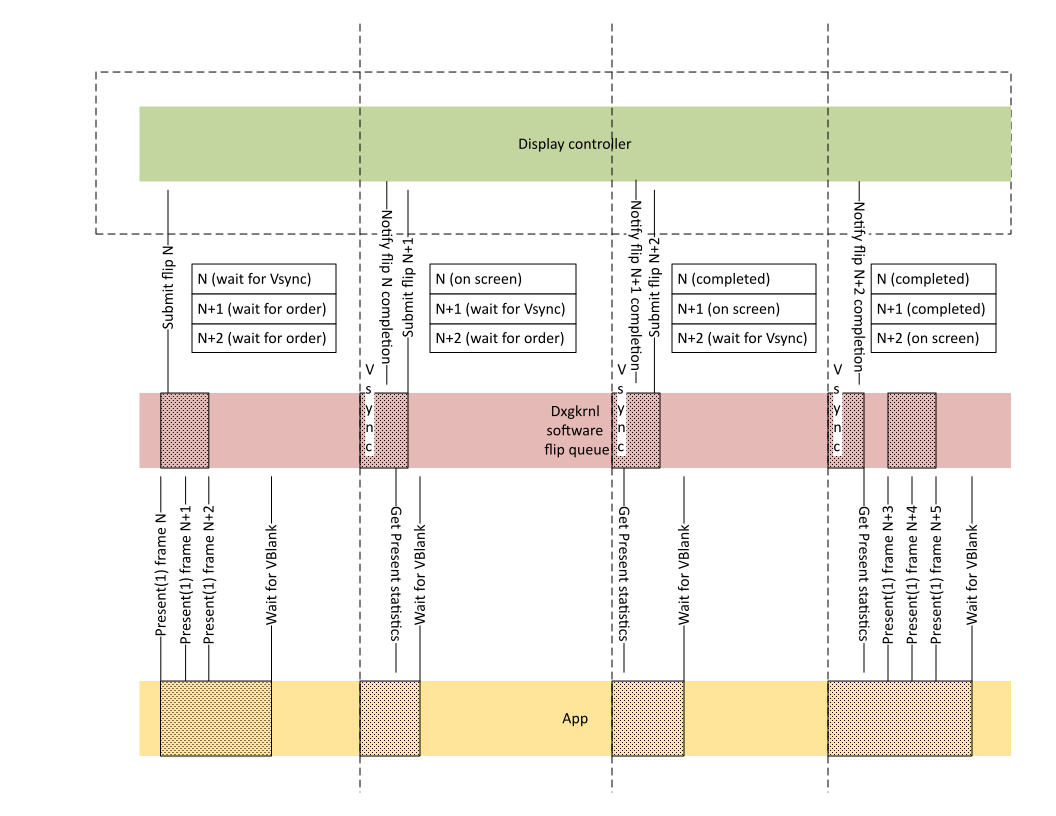
The fill pattern in the diagram shows the times when Dxgkrnl software flip queue processing and application threads have to wake up and do CPU work. On each VSync, the display controller has to issue a CPU notification to the OS for the completed flip, and the OS has to submit the next flip request. The application also has to wake up on each VSync and query present statistics to eventually learn when the last frame in the batch of three is displayed.
Hardware flip queue DDIs that can submit multiple future frames to the display controller queue are available starting in WDDM 3.0. As previously stated, this mechanism allows the CPU and parts of the GPU to transition to lower power states while the display controller is processing multiple queued frames. This transition improves power efficiency of video playback scenarios on capable hardware.
The following diagram illustrates the proposed architecture.
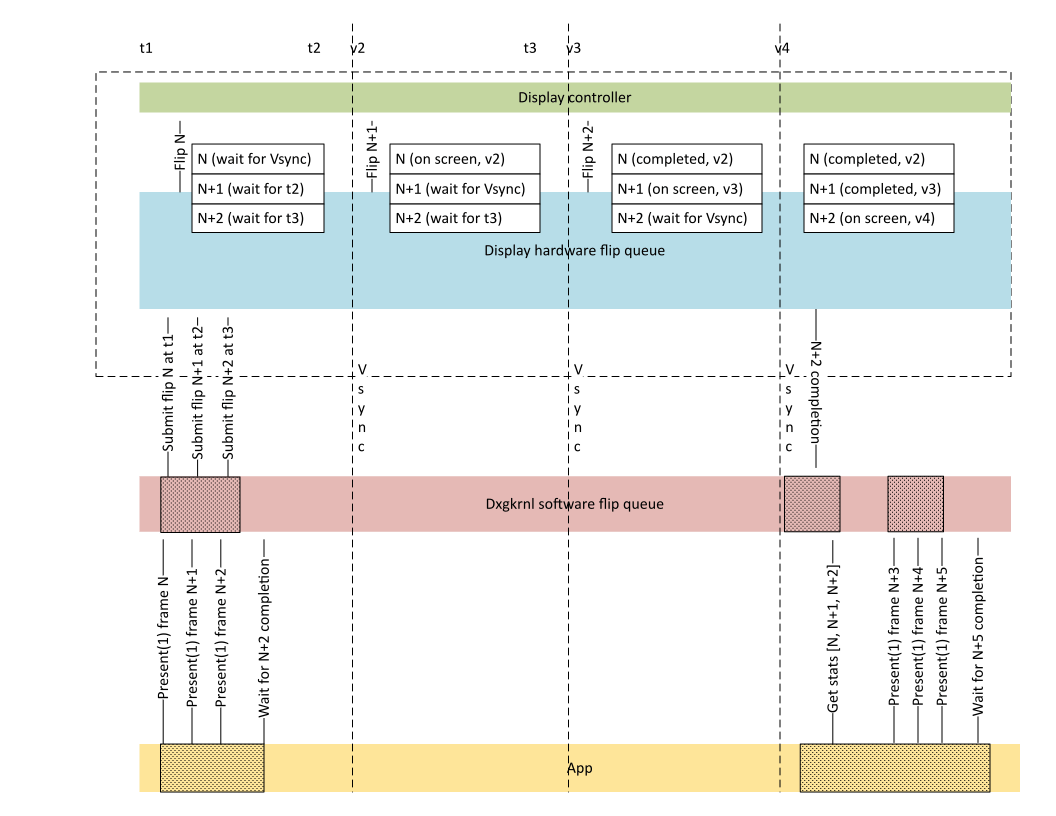
With the hardware flip queue approach, both the application and Dxgkrnl CPU components are fully idle for two VSync intervals between times v2 and v4, enabling the CPU to enter a low power state. The CPU is only notified when the frame N+2 that the application requested a wait for is completed.
Advanced hardware flip queue
In gaming scenarios before WDDM 3.0, after the GPU finishes rendering the scene to the swap chain back buffer, there's a roundtrip to the CPU in order to submit the request to present the frame contents to the screen. The following diagram shows this scenario.
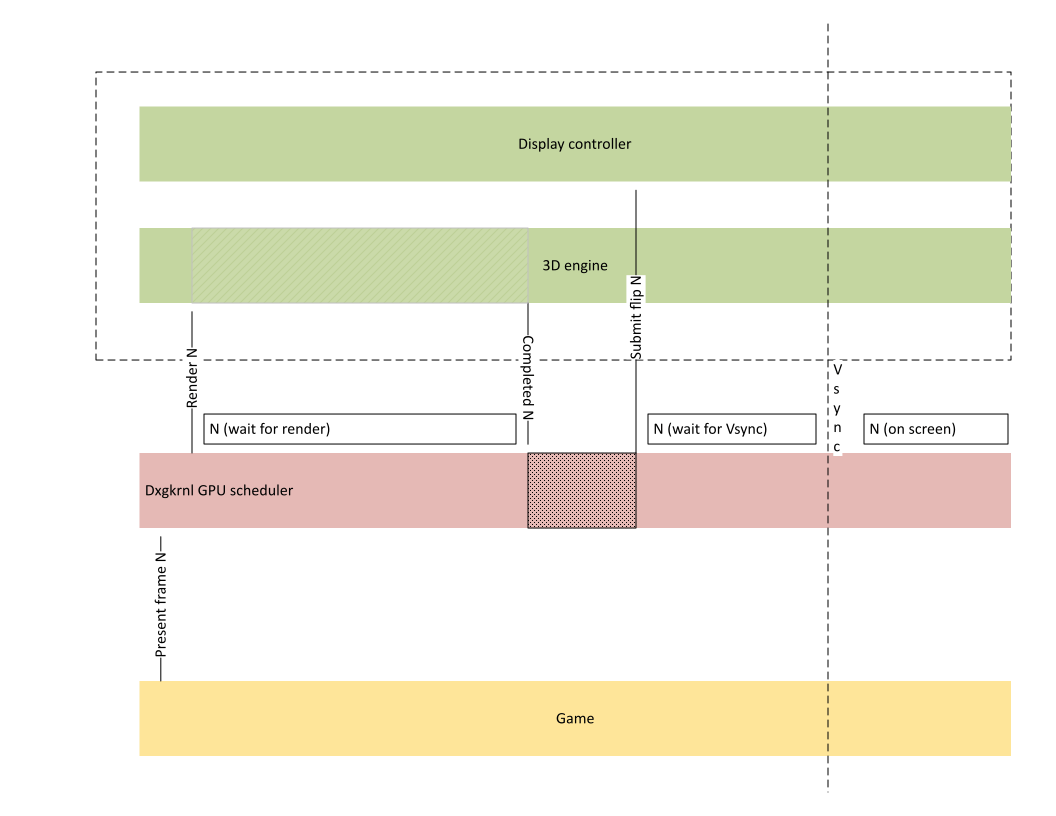
The cost of this roundtrip can cause frames to miss their target if the render is finished too close to the VSync, as shown in the following diagram.
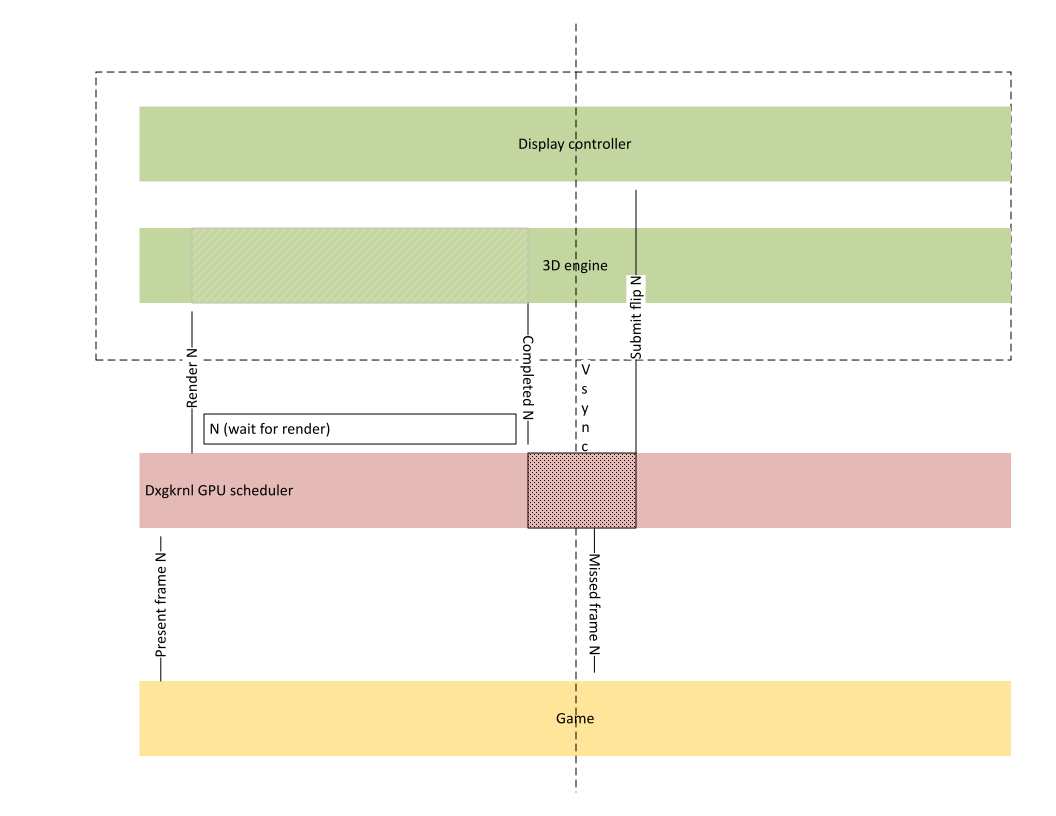
Some display controllers natively support wait conditions that allow the display to submit the flip request once the GPU is done rendering the frame without the CPU roundtrip. Because the hardware flip queue can submit the completed frame N to the display without a CPU roundtrip, it might avoid missed frames as shown in the following diagram.
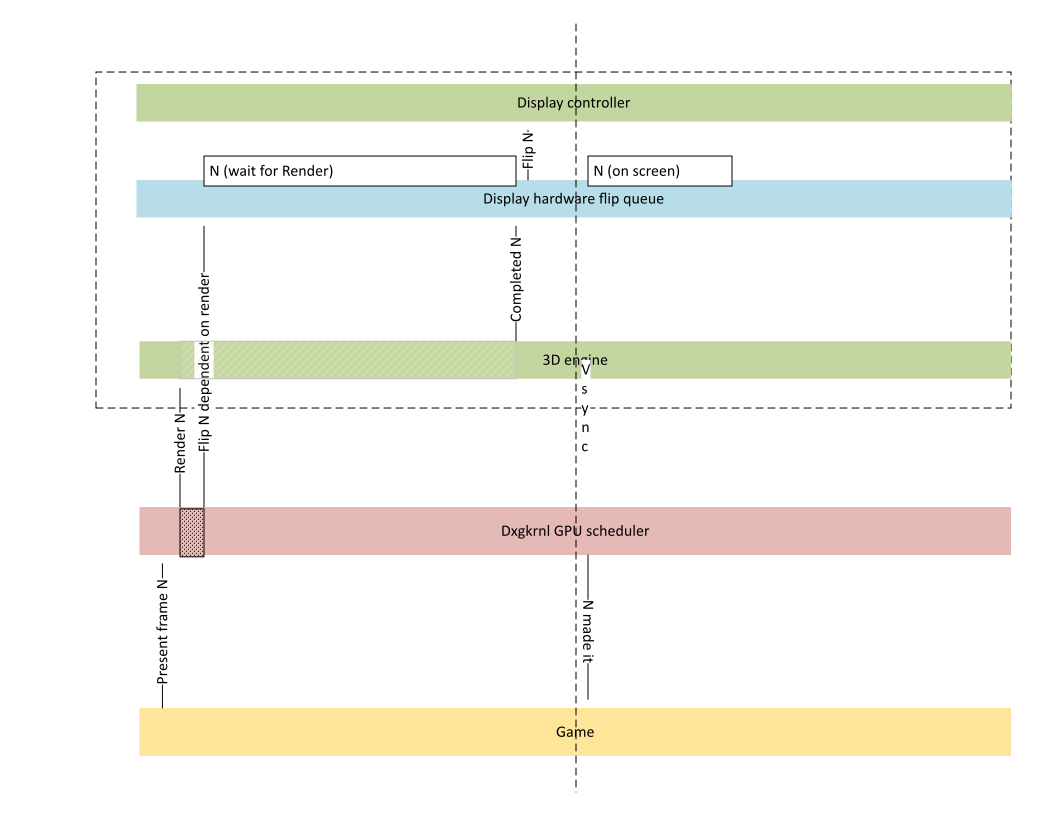
The remainder of this article discusses the basic hardware flip queue feature.
DDI support
The following DDIs were added to support the hardware flip queue feature.
Checking for feature availability
Hardware flip queue requires OS enable/disable negotiation. A KMD that supports hardware flip queue must first call DXGKCB_QUERYFEATURESUPPORT during device start time with a FeatureId of DXGK_FEATURE_HWFLIPQUEUE to determine whether the OS allows hardware flip queue to be enabled.
Hardware flip queue can only be used if the callback succeeds and Enable is set to TRUE.
A KMD can use the following sample code during hardware flip queue bring-up and experimental stages.
DXGKARGCB_QUERYFEATURESUPPORT HwFlipQueueEnabledArgs = {};
HwFlipQueueEnabledArgs.DeviceHandle = DeviceHandle;
HwFlipQueueEnabledArgs.FeatureId = DXGK_FEATURE_HWFLIPQUEUE;
HwFlipQueueEnabledArgs.DriverSupportState = DXGK_FEATURE_SUPPORT_EXPERIMENTAL;
if (!NT_SUCCESS(pDxgkInterface->DxgkCbQueryFeatureSupport(&HwFlipQueueEnabledArgs)) ||
!HwFlipQueueEnabledArgs.Enabled)
{
// Disable hardware flip queue because the OS didn't allow it.
}
else
{
// Enable hardware flip queue because the OS allowed it.
}
During driver bring-up, even though it's possible to enable hardware flip queue without enabling GPU hardware scheduling, this combination isn't officially supported. Windows currently requires GPU hardware scheduling to be enabled in order for basic hardware flip queue to be enabled on officially released drivers.
Indicating hardware queuing capabilities
MaxHwQueuedFlips was added to DXGK_DRIVERCAPS to indicate hardware flip queue support. If the OS allowed hardware flip queue support as previously described, a KMD that supports a hardware flip queue should set MaxHwQueuedFlips to a value greater than 1. When MaxHwQueuedFlips is greater than 1, KMD indicates that the display hardware supports up to MaxHwQueuedFlips future frames that can be queued to be displayed for a given VidPnSource on the GPU. The OS honors driver-provided restrictions on the type of flips that can be queued in advance.
HwQueuedFlipCaps was also added to DXGK_DRIVERCAPS. This member is currently reserved for system use; drivers shouldn't use it.
Flip target time and target timestamp format
When the OS submits a flip request to the hardware flip queue, it also sends the target flip time. The flip can be made visible to the user after the target flip time is reached.
The OS uses the CPU clock counter units, obtained from KeQueryPerformanceCounter, to pass the target frame time and interpret the actual frame time.
Submitting queued flips
The DXGKARG_SETVIDPNSOURCEADDRESSWITHMULTIPLANEOVERLAY3 structure, which is passed to KMD's DxgkDdiSetVidPnSourceAddressWithMultiPlaneOverlay3 callback function, was modified as follows to enable the submission of queued flips:
The following three members were added to OutputFlags's DXGK_SETVIDPNSOURCEADDRESS_OUTPUT_FLAGS structure. See DxgkDdiSetVidPnSourceAddressWithMultiPlaneOverlay3 retry and failure cases for details about these members.
- HwFlipQueueDrainNeeded
- HwFlipQueueDrainAllPlanes
- HwFlipQueueDrainAllSources
A TargetFlipTime member was added. TargetFlipTime describes the target flip time in QPC units. When the clock reaches this value, the frame can be sent to the display while honoring VSync and tearing flags. In the presence of previously queued pending flips, the OS guarantees that for each MPO plane referenced by the flip request, TargetFlipTime is greater than or equal to any of the pending flip target times for this plane. In other words, there can be a sequence of flips with the same or increasing timestamps, but there can't be a sequence that goes back in time.
DxgkDdiSetVidPnSourceAddressWithMultiPlaneOverlay3 retry and failure cases
Failure to queue the request to hardware due to pending flips
There are several special cases that might prevent KMD from queueing a flip request while other flip requests are pending. In such cases, KMD should return STATUS_RETRY from DxgkDdiSetVidPnSourceAddressWithMultiPlaneOverlay3 and set HwFlipQueueDrainNeeded equal to 1. The OS will attempt to submit the flip request again after all pending flips on planes affected by the flip are finished and once the target time is reached.
In some cases, display hardware might require completion of pending flips on all planes, not just the ones referenced by the incoming flip request. In this case, both the HwFlipQueueDrainNeeded and HwFlipQueueDrainAllPlanes flags should be set to 1, and KMD should return STATUS_RETRY.
Similarly, display hardware might require completion of pending flips on all VidPn sources in order to reallocate internal resources, in which case the HwFlipQueueDrainAllSources and HwFlipQueueDrainNeeded flags must be set, and KMD should return STATUS_RETRY.
In addition, KMD can indicate to the OS whether the resubmission should be done at the device IRQL (PrePresentNeeded set to 0), or if the OS should perform this call at PASSIVE_LEVEL (PrePresentNeeded set to 1). If KMD still returns STATUS_RETRY even though there are no more pending flips on that VidPnSourceId, this condition is treated as an invalid parameter failure.
It's important that the value of MaxHwQueuedFlips still reflects the maximum number of simple address-only change flips that can be queued to an MPO plane. The STATUS_RETRY mechanism should be used for more complex flip requests that can't be deeply queued, such as plane configuration changes.
Invalid parameter failure
In the hardware flip queue model, the OS's handling of failed flip requests was reworked to allow for better debuggability. When KMD is unable to process a flip request, it should return STATUS_INVALID_PARAMETER from DxgkDdiSetVidPnSourceAddressWithMultiPlaneOverlay3. Depending on OS settings, the OS performs one of the following actions:
- Kernel Debugger break and bug check: This behavior is often enabled on development / prerelease builds for better debuggability right as the failure condition occurs.
- Live Kernel Dump followed by a TDR: The retail end-user behavior.
Specifying VSync interrupt behavior
In order to achieve power savings in queued flip scenarios, the OS often suspends regular VSync interrupts to keep the CPU in a low power state. However, some flips are marked as requiring an interrupt to be raised in order for the application to observe the batch of completed presents and to queue further work. There are also cases when applications request to wake up on every VSync interrupt regardless of whether there are pending flip requests. And conversely, on a completely idle system, VSync interrupts are suspended until new presentation activity or VSync listeners appear.
To handle all of these cases, the following driver callback and callback structure were introduced:
KMD provides a pointer to its DxgkDdiSetInterruptTargetPresentId function in DRIVER_INITIALIZATION_DATA
The OS calls DxgkDdiSetInterruptTargetPresentId to specify the target PresentId that should result in a VSync interrupt raised when the corresponding flip is completed. This function is called at device interrupt level (DIRQL) to synchronize with DxgkDdiSetVidPnSourceAddress and the VSync interrupt.
Interaction with DxgkDdiControlInterrupt
When VSync interrupts are disabled entirely via DxgkDdiControlInterrupt/DxgkDdiControlInterrupt2/DxgkDdiControlInterrupt3, they stay disabled regardless of the interrupt target PresentId value. KMD is required to store the latest interrupt target present ID so that it can be honored once VSync is enabled again.
When VSync interrupts are enabled via DxgkDdiControlInterruptXxx, the interrupt target present ID (pSetInterruptTargetPresentId) provides finer grained control as follows:
When the target present ID is set to UINT64_MAX, no VSync interrupt is required going forward until the target present ID is changed again. VSync interrupts are disabled, but KMD is required to implement DXGK_VSYNC_DISABLE_KEEP_PHASE behavior for re-enabling interrupts.
When the target present ID is set to 0, interrupts are required for every VSync.
For any other present ID value, interrupts are raised if the currently scanned PresentId >= InterruptTargetPresentId.
When multiple MPO planes are available, the VSync interrupt should be raised if any of the planes require it.
2-Stage VSync disable with DxgkDdiSetInterruptTargetPresentId
If the OS call to DxgkDdiSetInterruptTargetPresentId sets an InterruptTargetPresentId on a plane that would lead to disabling VSync entirely on this VidPnSource (that is, this plane was the last plane that kept VSync enabled, and now this plane is disabling VSync as well), KMD should disable VSync interrupts but keep the VSync phase in hardware enabled (DXGK_VSYNC_DISABLE_KEEP_PHASE). After a certain time period (typically equivalent to two VSync periods), the OS will follow up with a call to DxgkDdiControlInterruptXxx with DXGK_VSYNC_DISABLE_NO_PHASE. This call ensures that KMD gets a chance to disable the VSync phase and VSync clocks to save maximum power and to maintain performance parity with nonhardware flip queue systems.
Queued flip cancellation
In cases such as full screen state transitions or application exits, future queued flips might need to be canceled. To handle these cases, the following driver callback and related structures were introduced:
KMD provides a pointer to its DxgkDdiCancelFlips function in DRIVER_INITIALIZATION_DATA.
The OS specifies the range of queued flips to cancel when it calls DxgkDdiCancelFlips, and KMD reports back to the OS the range of flips it was able to cancel synchronously.
The following example illustrates the mechanics and synchronous case of flip cancellation on a single plane. (The OS doesn't support asynchronous cancel in Windows 11, version 22H2.) Imagine the following flips are being queued to the hardware flip queue:
- PresentId N
- time t0 PresentId N+1
- time t1 PresentId N+2
- time t2 PresentId N+3
- time t3 PresentId N+4
- time t4
The OS then decides to cancel flips N+2, N+3, and N+4, so it calls DxgkDdiCancelFlips with PresentIdCancelRequested set to N+2.
When KMD inspects the hardware flip queue state, it determines that:
- Flip N+2 is already sent to the display hardware and can't be canceled at the time of the call.
- Flips N+3 and N+4 can be synchronously removed from the hardware flip queue without side effects.
As a result, KMD sets PresentIdCancelled to N+3 and completes N+2 as usual.
The OS marks N+3 and N+4 as canceled, and it treats N, N+1, N+2 as being in flight. When the next VSync interrupts are raised, the flip queue log will indicate the timestamps for N, N+1, N+2 as usual.
The range of synchronously canceled flips has to be continuous and, when not zero, is assumed to include the last present ID submitted to KMD. In other words, there can be no gaps inside both synchronous canceled flip ranges.
Cancelling interlocked flips on multiple planes
An interlocked flip is submitted by calling DxgkDdiSetVidPnSourceAddress with multiple planes and PresentIds. The contract between the OS and KMD follows:
- The set of planes must be made visible on the same VSync.
- The display hardware isn't allowed to only display a subset of these planes on one VSync, and the rest on the next VSync.
In the hardware flip queue model, such interlocked flips are canceled by passing multiple planes and PresentIds in the call to DxgkDdiCancelFlips. The set of planes passed in such cases must correspond to a pending interlocked flip request, and KMD's decision regarding all of the interlocked PresentIds must be the same:
- Don't cancel, or
- Cancel synchronously
DxgkDdiCancelFlips is called at the device interrupt level (DIRQL) to synchronize with DxgkDdiSetVidPnSourceAddress and VSync interrupt.
Obtaining present statistics for queued flips
Since the hardware flip queue approach is to avoid waking up the CPU on each VSync, there needs to be a mechanism to retain frame display times for the last several queued flips.
Graphics drivers that support hardware flip queue must write information to the OS-provided flip queue log buffer for each completed or canceled flip for a given MPO plane for each active VidPnSource.
The OS guarantees to provide the flip queue log pointer (in a call to DxgkDdiSetFlipQueueLogBuffer) before the first DxgkDdiSetVidPnSourceAddress call for a given MPO plane for each active VidPnSource. The OS is allowed to destroy the flip queue log buffer when the flip queue doesn't have any outstanding requests. In this case, it will provide a new log pointer before the next DxgkDdiSetVidPnSourceAddress call. The flip queue log is circular. Once the [NumberOfEntries-1] entry is written, the next log entry is [0].
After a batch of queued flips is completed, KMD has to guarantee that the flip queue log for the completed flips is updated at the earliest of these two points in time:
- A VSync interrupt handler for a flip that required an interrupt to be raised.
- In response to an explicit DxgkDdiUpdateFlipQueueLog request from the OS.
Flip queue log DDIs
The following flip queue log-related callback and associated structures were added:
KMD provides a pointer to its functions in DRIVER_INITIALIZATION_DATA.
VSync interrupt structure updates
The following changes were made to the DXGKARGCB_NOTIFY_INTERRUPT_DATA structure to implement VSync interrupts for the hardware flip queue model:
- The DXGK_INTERRUPT_CRTC_VSYNC_WITH_MULTIPLANE_OVERLAY3 enum value was added as the InterruptType.
- The CrtcVSyncWithMultiPlaneOverlay3 structure was added to the union. CrtcVSyncWithMultiPlaneOverlay3's semantics are similar to the existing CrtcVSyncWithMultiPlaneOverlay2 structure, except that instead of a single last completed PresentId for each plane, CrtcVSyncWithMultiPlaneOverlay3.pMultiPlaneOverlayVSyncInfo points to the range of previously unreported PresentIds from the flip queue log.
- The DXGK_MULTIPLANE_OVERLAY_VSYNC_INFO3 structure was added for CrtcVSyncWithMultiPlaneOverlay3's pMultiPlaneOverlayVSyncInfo member.
Using the Basic hardware flip queue example diagram again:

Assume FirstFreeFlipQueueLogEntryIndex was set to 40 at the time flip N was submitted and then N, N+1, N+2 presents were completed.
After a single plane configuration completes three PresentIds N, N+1, and N+2 at respective times v2, v3, v4, KMD has written three new entries in its flip queue log buffer with indices 40, 41, and 42. KMD reports a FirstFreeFlipQueueLogEntryIndex value of 43 in the CrtcVSyncWithMultiPlaneOverlay3 structure. The OS observes that FirstFreeFlipQueueLogEntryIndex changed from 40 to 43, and reads from log entries 40, 41, and 42. KMD needs to set the following flip queue log buffer values as follows:
VidPnTargetId: same meaning as in CrtcVSyncWithMultiPlaneOverlay2
PhysicalAdapterMask: same meaning as in CrtcVSyncWithMultiPlaneOverlay2
MultiPlaneOverlayVSyncInfoCount = 1
pMultiPlaneOverlayVSyncInfo[0].LayerIndex = 0
pMultiPlaneOverlayVSyncInfo[0].FirstFreeFlipQueueLogEntryIndex = 43
LogBufferAddressForPlane0[40].PresentId = N
LogBufferAddressForPlane0[40].PresentTimestamp = v2
LogBufferAddressForPlane0[41].PresentId = N+1
LogBufferAddressForPlane0[41].PresentTimestamp = v3
LogBufferAddressForPlane0[42].PresentId = N+2
LogBufferAddressForPlane0[42].PresentTimestamp = v4
Explicit flip queue log update request
There are cases when the OS needs to obtain information about the last completed batch of flips without having to wait for the VSync interrupt. In such cases, the OS makes an explicit call to DxgkDdiUpdateFlipQueueLog to request that KMD read from its proprietary display hardware data structure and write past flip information to the flip queue log. Semantics of the log are the same as previously described; the only change is that FirstFreeFlipQueueLogEntryIndex is returned to the OS outside the VSync interrupt.
DxgkDdiUpdateFlipQueueLog is called at the device interrupt level (DIRQL), and it's in the same synchronization class as DxgkDdiSetVidPnSourceAddressWithMultiPlaneOverlay3 DDI.
Display mode changes and power transitions in the presence of a queued flip in the hardware flip queue
Dxgkrnl ensures that already queued flips in the hardware flip queue are completed or canceled before initiating a mode change or powering down the monitor.
Mapping Present requests to hardware flip queue timestamps
When hardware flip queue is enabled on a particular adapter, a timestamp accompanies all flip calls. In other words, KMD doesn't need to handle a mix of old and new DxgkDdiSetVidPnSourceAddress semantics.
The OS automatically converts existing interval-based Present API requests to timestamp-based flip calls to KMD. The following sections discuss various cases and how they're mapped to a combination of flags, Duration, and timestamps received by KMD.
Tearing and nontearing flips semantics
The semantics of tearing flips are conceptually the same when hardware flip queue is enabled. Once the TargetFlipTime is reached, KMD should submit the flip to display while still honoring flags such as FlipImmediate, FlipImmediateNoTearing, and FlipOnNextVSync. In other words, KMD should behave as if the OS submitted the flip to it exactly at TargetFlipTime with the same flip flags and parameters.
For example, if FlipOnNextVSync is set to 1 and the TargetFlipTime is in the middle of the frame, the flip should only be displayed on the next VSync.
FlipOverwrite support and hardware flip queue
Hardware flip queue is a strict superset of the flip overwrite feature controlled by MaxQueuedMultiPlaneOverlayFlipVSync value in DXGK_DRIVERCAPS.
Therefore, the OS ignores MaxQueuedMultiPlaneOverlayFlipVSync value if the driver opts into the hardware flip queue by setting MaxHwQueuedFlips to a value greater than 1.
Multiple flips with an expired TargetFlipTime
When there are multiple queued flips with an expired TargetFlipTime for a given MPO plane, the hardware display queue must pick the most recently queued expired flip and submit it to display. The rest of the expired flips should be treated as canceled, and corresponding flip queue log entries for them should contain DXGK_HWFLIPQUEUE_TIMESTAMP_CANCELLED as the PresentTimestamp values.
Interaction between Duration and TargetFlipTime
The Duration parameter in the DXGKARG_SETVIDPNSOURCEADDRESSWITHMULTIPLANEOVERLAY3 structure should take effect when the flip specified in this structure is displayed on the screen. It specifies the new desired display refresh rate behavior for the output specified by VidPnSourceId across all planes. In the WDDM 3.1 and Windows Server 2022 releases, in order to simplify driver implementation for hardware that doesn't support queued custom Duration changes, the OS only submits flip requests with a new Duration parameter after previous flip requests are completed.
Mapping Present intervals to TargetFlipTime
Mapping intervals when refresh rate is fixed
To preserve existing present interval semantics, the OS has to calculate the target flip time using the present interval and refresh rate. However, setting the target flip time exactly to the intended VSync time at which the flip should hit the screen results in frequent glitches. These glitches are due to the missed VSync when the actual VSync timing drifts a bit. To guard against glitches, the OS subtracts half of the VSync interval from the calculated target flip time.
Here's a simplified formula for mapping the present interval to the target flip time:
TargetFlipTime = PreviousFlipStartVSyncTime + (PreviousFlipPresentInterval * FixedRefreshRate) - (FixedRefreshRate / 2)
Mapping intervals when the virtual refresh rate WDDM 2.9 feature is present
The virtual refresh rate feature might temporarily boost the display refresh rate to an integer multiple of the current refresh rate (that is, 24 Hz can be boosted to 144 Hz or 192 Hz). For devices that are capable of supporting this boost, the formula in the previous section is modified to use the fastest multiple of the current refresh rate:
TargetFlipTime = PreviousFlipStartVSyncTime + (PreviousFlipPresentInterval * FixedRefreshRate) - (FastestRefreshRate / 2)
Mapping intervals when refresh rate is changed to a nonmultiple
When the refresh rate is changed to a nonmultiple of a current refresh rate (for example, from 24 Hz to 60 Hz), the OS needs to inspect the queue flips to see if their calculated target time is still valid for the new refresh rate. If the target flip time needs to be changed, the OS cancels queued flips and requeues them with the newly calculated target flip times.